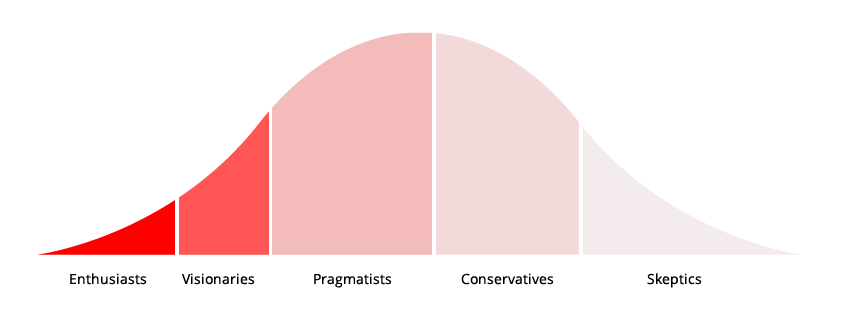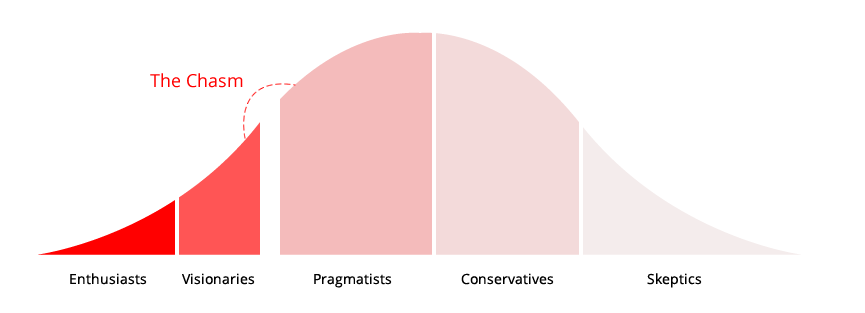In preparation for the first edition of Crossing the Chasm in 1991, its author, organizational theorist and consultant Jeffrey Moore expected the book’s sales figures to be around 5000 copies; the title went on to sell over 300,000 copies in ten years, led to seven follow-up books, and was called the bible for entrepreneurial marketing by the director of the Stanford Technology Ventures Program.
Crossing the Chasm explores the challenges of marketing innovative products during the start-up phase, and provides a strategic framework for continued growth and expansion. In the current article, we provide a condensed executive summary of the book for those who wish to quickly (~15 min) familiarize themselves with its core idea before reading in full – or recap after having read it earlier.
-
Diffusion of innovations: introducing the five stages of the technology adoption cycle. At the foundation of the author’s discussion lies the Diffusion of Innovations theory popularized by E. Rogers in the 1960s. Widely considered the standard model in its field, Diffusion of Innovations argues that adoption of new ideas and technologies throughout a given population does not happen smoothly – rather proceeds in stages, spanning 5 distinct groups. Before we look at each in more detail, it should be noted that the book focuses foremost on the B2B (business to business) markets, and the discussed framework is better viewed from that perspective.

The first group is the innovators (Moore calls them tech enthusiasts) for whom owning the latest everything is a passion and an end in itself. They proactively seek out new products to try them out, requiring almost no marketing efforts from your part, yet they constitute a small percentage of the population, in low single-digits.
Next, there are early adopters (or visionaries in Moore’s terms) in search of competitive advantages provided by new products and services. They view technology as a means of achieving breakthroughs and aggressively gaining market edge.
The two groups discussed above together account for ca 15% of the total market and can be conquered with little to no effort because of their open-minded predisposition and proactive stance. Since this segment is rather small and is usually unable to support your new product indefinitely, it is of utmost importance to gain traction with the next group, the early majority (called pragmatists in the book) – a healthy one-third of the entire population and the key to getting a stable foothold on the market.
Pragmatists do not get thrilled by innovations per se, nor do they go after drastic changes – incremental improvements via a stable, well-supported product or service is what turns them on. Despite being.. well.. pragmatic, this group makes for very loyal customers if treated right – which means winning them over is absolutely essential in securing growth and profitability.
The next segment, dubbed late majority (or conservatives per Moore) accounts for another third of the entire market, yet they are characterized by demanding easy to use, value-for-money products before anything else. They can be regarded as an extension of the pragmatists with higher resistance toward new tech stemming mostly from unwillingness to face the hassle of upgrading their existing solutions and processes.
Finally, the late majority is followed by the so-called laggards, or skeptics – the group that actively prefers anything new to the status quo. As clients they can be very tough to win and are therefore often ignored by many marketing efforts, yet can provide important feedback regarding the areas where your product could be further improved – made even simpler, cheaper and more convenient to use.
-
Between the visionaries and pragmatists segments lies a chasm where many new products fail. Ideally, the movement of a new technology along the adoption line discussed above retains momentum as each conquered group provides a reference point for marketing to the next one as the product gains market traction. In reality, however, this process often unfolds in steps, with the greatest discontinuity lying between the early and the mainstream markets, i.e. between the visionaries and the pragmatists.

This chasm, as the author calls it, stems mainly from the vastly different motivations for using the new product: while visionaries seek out dramatic shifts in productivity which can enable them to quickly move forward, even despite resistance from within their own companies, the pragmatists want gradual, steady improvements, making sure no drastic changes occur too fast.
Because of this, pragmatists are usually not lured in by visionaries’ recommendations as they demand established products with matured infrastructures. In other words,
pragmatists want mainstream products which are endorsed by the market majority, all the while being the market majority themselves.
This neat catch-22 situation prevents many new products from ever reaching the mainstream market, remaining low-volume niches or even fading into oblivion.
In order to escape this fate and make it to the main market, companies need to have a carefully devised plan for crossing the chasm. Moore offers a viable strategy that can help new products achieve mainstream success.
- Get a foothold by conquering a specific mainstream niche with a whole product. The book’s author argues that the process of going mainstream should be taken as a matter of life and death for your product: planning the “invasion” in advance will greatly increase your chances of survival.
The key idea behind Moore’s entry strategy is first securing a small, well-defined niche within the larger pragmatist group and becoming its undisputed leader. This will act as the first domino piece that launches the avalanche of new customers and profits for your product throughout the mainstream market.
Before launching a full-scale invasion, it is crucial to obtain a stable foothold on the new shore, a proxy base of sorts that you can act from when conquering the rest of the domain.
It is worth emphasizing the word “small” in the previous statement: the larger the target niche, the more difficult it will be for you to come up with all necessary ingredients that please the pragmatist buyers, including, foremost, quickly winning the majority to your side.
There is one more important factor to take into account: since pragmatists like to avoid unnecessary hassle while adopting a new product, it is extremely important to fully prepare your offer for crossing the chasm. While the earlier segments are okay with or even enjoy the challenges of integrating new technologies into their existing flow, pragmatists demand the so-called whole products: installation, infrastructure, and support inclusive.
You will most probably need to make additional investments and set up new strategic partnerships in order to ensure that your product meets the expectations of the pragmatist group, yet these outlays will pay off manyfold once you secure your foothold in the mainstream market.
Once you manage to satisfy the demands of a carefully chosen niche within the broader pragmatist group, you will not only develop the infrastructure and partnerships required for conquering the entire mainstream market, but also obtain the essential references and word of mouth to propel your product into other niches of the largest market segment and beyond.
Read the Full Summary in Blinkist
Blinkist is a freemium service that offers easy to digest abstracts of popular non-fiction books in structured summaries called blinks. In addition to the main ideas covered above, in the Crossing the Chasm blink you will learn about:
- Choosing the best niche to target for your initial mainstream campaign
- Distribution channels to use to cater to the pragmatist group
- Crossing the chasm in consumer markets vs B2B markets
- Addressing the post-chasm challenged to retain market leadership
You can read the full summary for free by clicking this link and creating a Blinkist account:
Crossing the Chasm: Blinkist Summary ›
– or take a look at our expert’s review of the Blinkist service itself here to find out how you can combine it with reading full books for maximum efficiency (plus, get a 35% discount on your first year!)



I do like the alternative names given by mr. moore to the market segments, becuase they better describe their inner motivations for adopting the products, but the fact that this book is based so much on the diffusion of innovations theory makes it somewhat derivative in my view
didnt realize diffusion of innovations and this thing were the same idea. So much for my 3 years in business school
Thanks so much for the post.Really thank you! Great.